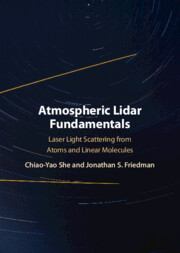Book contents
- Atmospheric Lidar Fundamentals
- Atmospheric Lidar Fundamentals
- Copyright page
- Dedication
- Contents
- Foreword
- Preface
- 1 Introduction
- 2 Classical Light Scattering Theory
- 3 Semiclassical Treatment of Light Absorption and Scattering from Atoms
- 4 Rayleigh and Raman Scattering from Linear Molecules
- 5 Introduction to Lidar Remote Sensing and the Lidar Equation
- 6 Common (Broadband) Lidar Types and Associated Applications
- 7 Lidars for Profiling Aerosol Optical Properties, Atmospheric Temperature and Wind
- 8 Transmitting and Receiving Optics
- Book part
- Index
- References
5 - Introduction to Lidar Remote Sensing and the Lidar Equation
Published online by Cambridge University Press: 24 February 2022
- Atmospheric Lidar Fundamentals
- Atmospheric Lidar Fundamentals
- Copyright page
- Dedication
- Contents
- Foreword
- Preface
- 1 Introduction
- 2 Classical Light Scattering Theory
- 3 Semiclassical Treatment of Light Absorption and Scattering from Atoms
- 4 Rayleigh and Raman Scattering from Linear Molecules
- 5 Introduction to Lidar Remote Sensing and the Lidar Equation
- 6 Common (Broadband) Lidar Types and Associated Applications
- 7 Lidars for Profiling Aerosol Optical Properties, Atmospheric Temperature and Wind
- 8 Transmitting and Receiving Optics
- Book part
- Index
- References
Summary
In Chapter 5, having introduced the physics behind light scattering, we present the lidar equation. This sets the stage for consideration and simulation of various types of lidar. These include the following broadband lidars: Rayleigh–Mie, polarization, vibrational Raman and fluorescence, and differential absorption. They also include high–spectral resolution (narrowband) lidars: Lidar ratio and aerosol properties, temperature profiling by integration Rayleigh+Raman, temperature profiling with rotational Raman and Cabannes scattering, Rayleigh–Mie wind profiling, and mesopause–region resonance fluorescence wind+temperature profiling.
- Type
- Chapter
- Information
- Atmospheric Lidar FundamentalsLaser Light Scattering from Atoms and Linear Molecules, pp. 94 - 102Publisher: Cambridge University PressPrint publication year: 2022

